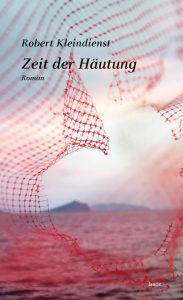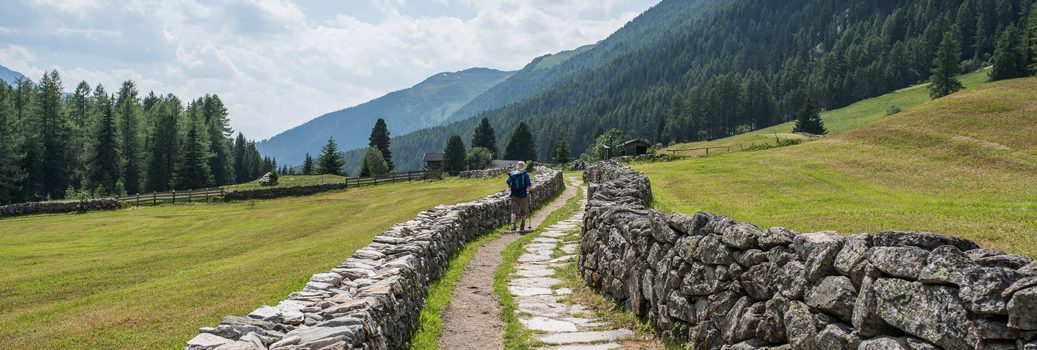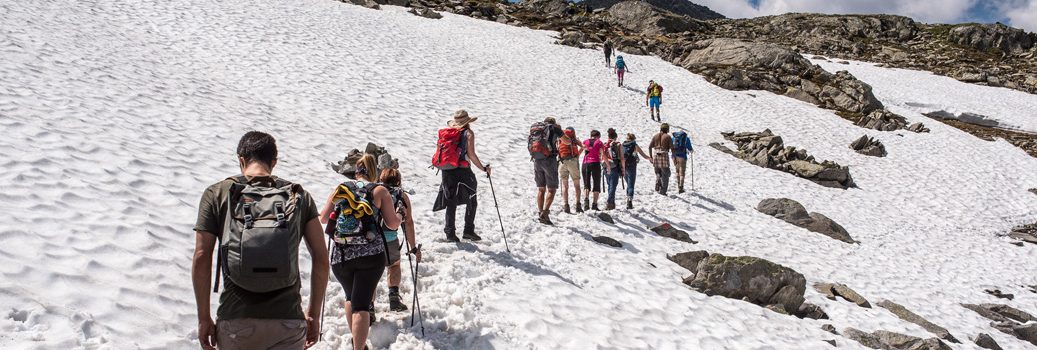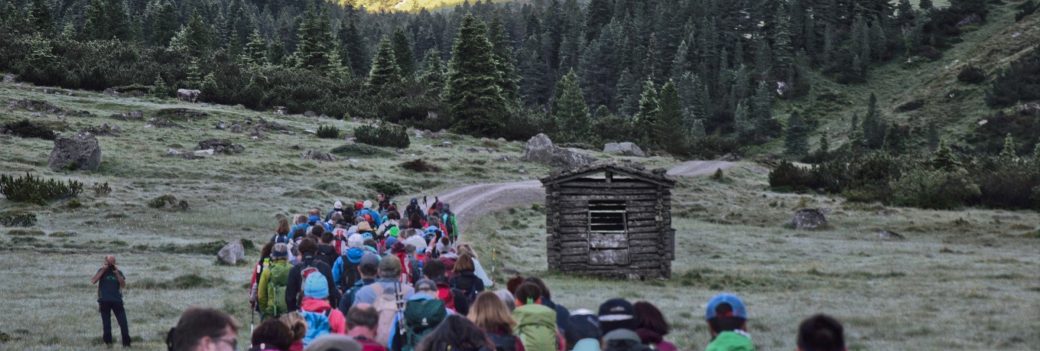At the time of the fascist Ustasha regime in Croatia, there were children’s concentration camps where children of enemies of the regime were imprisoned and murdered. All this happened with the acquiescence or partial support of the Catholic Church. As a reader of his novel “Zeit der Häutung” (2019), one follows Robert Kleindienst’s protagonist, the Croatian Ana Sadak, who worked as a nurse’s aide* in one of these cruel camps, on her adventurous escape from the Yugoslavian army in 1945. Ana is first drawn to Altaussee, where she waits in a secluded hunting lodge for the turmoil of the postwar period to subside and hopes to shed her past. She then travels on to the city of Salzburg, where, with the help of the Catholic Church, she is given a new identity and flees along the so-called Rat Line across the Krimmler Tauern to South Tyrol and then on to Genoa. Her destination: South America.
In conversation with Antonia Winsauer, author Robert Kleindienst talks about the challenges of turning a historical material into a novel. Translated by Hilde Mayer.

Mr. Kleindienst, we discussed in the run-up to this interview that today, in relation to your novel “Zeit der Häutung,” we’re talking primarily about the challenge of working on a historical material, of taking various aspects of the past and turning them into fiction, of mixing historical reality and fiction. How would you describe the process of choosing the subject matter?
The basic idea for “Zeit der Häutung” came about in the course of my research for what was then actually my planned third novel, which is about the Jewish sports club Hakoah, set in Vienna in the 1920s and 1930s. I came across the Ustasha and its children’s concentration camps, read up on them and soon had the urgent need to write something about them. I studied the subject very intensively and came across the escape route via Salzburg, through which the members of the Ustasha had fled. As a result, I deepened my research on the “rat line”, which also appears in the novel, and so the whole thing slowly became a novel theme that touched me deeply, especially the images of the children in the camps. It was clear to me that this topic is not really known here in Austria. We associate the word “Ustasha” with fascism, but that’s all we know about the subject. And there is by far more secondary literature on the “Rat Line” than there are adaptations of the novel. In my research, I found that there is very little secondary literature on these children’s concentration camps – in contrast to the “Rat Line” – especially in German or English. A friend helped me translate some of what I found. I also wanted to address the Croatian children’s concentration camps, which are to be distinguished from the camps in Nazi Germany, a topic that is rarely addressed, even in Croatia itself, where, according to the Croatians I interviewed, the civil war of the 1990s and the time of Tito tend to come up when it comes to Croatian history. I worked a lot with visuals, because it was important for me to get the historical details right, for example in the description of the city of Salzburg in the early post-war period.
Your Croatian protagonist Ana Sadak is on the run, stopping at various stations in the course of the plot: After her homeland and her service as a nurse’s aide in a Ustasha children’s concentration camp, these are a hunting lodge in Altaussee, the city of Salzburg, the Krimmler Tauern, South Tyrol and Genoa. South America is the destination of her escape. How did you come to choose these locations?
First and foremost, I wanted to use places along the so-called “rat line” from South Tyrol to Genoa as places of action. Genoa was not only a pivotal point for representatives of the Ustasha, but also for the escape of the National Socialists to South America, as was Rome, where many hid in monasteries etc. before fleeing to South America. Salzburg was important to me not only because of its significance for the “Rat Line” as a plot location, but also because I have a personal connection to this city, having lived here for a very long time. In my search for a place where Ana could go into hiding, which was secluded and at the same time associated with National Socialism and Fascism, I came across Altaussee. Numerous Nazi celebrities were on location here, the high-ranking SS functionary Ernst Kaltenbrunner, for example, who appears in the novel; and Simon Wiesenthal reports that he almost arrested Adolf Eichmann in Aussee. As for the plot locations in Croatia, they simply arose – Zagreb, for example, where Ana receives her schooling, and the camp I describe was again a historical location that arose for the plot because of its importance.
We at Alpine Peace Crossing are of course particularly interested in the role of the Krimml Tauern, over which your protagonist also flees. From 1945 onwards, it was not only a means of escape for numerous Jews on their way to present-day Israel, but also a section of one of the so-called rat lines along which National Socialists and Fascists fled to South America via Rome and Genoa with the help of the Vatican. How was it for you to connect these two types of escape in the novel?
I read, and perhaps you know this from history, that the Krimml Tauernhaus was partly occupied by Nazis, and one floor below slept Jews who had survived concentration camps. In this house, perpetrators and victims met. I found such a place very exciting as a setting.
So perpetrators and victims met in this house. I found such a place very exciting as a setting.
From a window of the Tauern House, Ana observes dark figures who set out at night to flee across the Tauern. She, though not the classic perpetrator type, then joins a small group of fugitives on their own flight over the Tauern, of whom we don’t know exactly what they were doing during National Socialism. Simon, the character who accompanies Ana’s group as a mountain guide over the Krimml Tauern, stands for one of those people who, motivated primarily by economic considerations, supported people on their flight, regardless of their respective personal backgrounds, as a “bread and butter,” so to speak. Another reason for Ana to choose the route over the Krimml Tauern was the historical circumstances – the Brenner Pass was already closed at that time and thus virtually excluded as a possibility of escape. According to the descriptions of Marko Feingold, in the spring of 1946 there was relatively little activity regarding the escape over the Krimml Tauern, but a year later many more people took this escape route. I also found the person Liesl Geisler, the landlady of the Tauernhaus at that time, exciting. She also appears in my novel, but not by name.
The Tauernhaus was one of the places I visited during my preparations for the novel. The conversation I had with the current landlord during my visit to the Tauernhaus was interesting, but at the same time not very informative. I had the feeling that he didn’t really want to talk about what had happened back then. His answers to my questions were relatively brief. With banal questions such as whether there had already been a telephone in the Tauernhaus in 1946 – in my novel there is also a telephone call, I wanted to check that -, he was then again more willing to provide information.
The protagonist Ana is fictional, but in “Zeit der Häutung” you combine fictional characters and historical figures. What is the attraction and challenge of such a mixture?
For me, it was a fundamental question of whether or not to call historical figures by their proper names in the novel. For example, the model of the camp guard Toma described in the novel was a Franciscan priest named Miroslav Filipović, who actually worked as a guard in Ustasha camps. I considered in advance of writing whether or not to mention historical figures like him by name, but then decided against it. This combination – naming historical figures by their real names and a fictional main character – just wouldn’t have fit for me, I had qualms about that. It was clear to me that if I included real people, then everything had to be historically correct and I couldn’t impute anything to this person. I then solved this by taking historical persons such as Miroslav Filipović as a basis for characters like the camp guard Toma, and subsequently codifying them and adapting them to the plot. Other examples of historical figures that appear coded in my novel are Diana Budisavljević, who supports Ana in the camp as a helper, and Krunoslav Draganović, on whom Ana’s escape helper Damir in the city of Salzburg is based.
Has the question arisen for you whether, and if so, how, as a writer, one can do justice to historical persons in both positive and negative respects by incorporating them into a fictional plot, even without coding them?
Of course. However, in the case of historical persons such as Ante Pavelić, who was dictator of the Independent State of Croatia from 1941 to 1945, there was simply no other option for me than to mention them by name as historical landmarks. Coding them here would not have made sense to me, partly because Pavelić actually appears only in passing and I did not describe him in detail. In the case of figures such as the camp commander Toma mentioned earlier, for whom I was indeed guided by Filipović, I tried to capture the respective personality as best I could, for example by interpreting photographs or with the help of historical records of former prisoners of the children’s camps.
Conversely, there was certainly also the question of whether purely fictional characters could do justice to the historical events and what people experienced back then. Did you have any fear of contact? If so, how did you deal with them?
I was already concerned about whether Croatians who read my novel might give me the feedback that I, as an Austrian, actually have no idea about Croatian history and therefore shouldn’t write about it. A preoccupation with the question of whether I can do justice to what I am addressing goes back to the origins of my writing: at the age of 18, I wrote a book about the Lakota Indians, in which I addressed the changes in the living conditions of this tribe. At that time, I happened to have the opportunity to ask a Lakota Indian who was a guest in Salzburg what he thought of my writing a young adult novel about his people as an Austrian. He confirmed me in what I was doing by saying that it was important for someone to deal with the life of his people, to show interest in it even outside his own culture and to take up the subject. There is, of course, a danger of drifting into certain clichés when dealing with sensitive issues. But I don’t think the solution is not to write fiction about it at all.
At the end of the novel, your protagonist is faced with the question of whether she can shed her own past and look ahead to a new life in South America. What significance would you attach to the themes of perpetration and victimhood, historical responsibility and dealing with the past for “Zeit der Häutung”?
I wanted to draw Ana as a person who is aware that she did something that wasn’t right. She doesn’t justify herself like many others do by invoking command necessity, doesn’t turn off her conscience, but is someone who always has it rattling around in the back of her mind, someone who the past never lets go of but always catches up with her. I wanted to describe her as being a split person: on the one hand, she knows that she supported the children who were in the Croatian concentration camp, but on the other hand, she also realizes that she was part of the Ustasha system.
I wanted to describe her in such a way that for me she is a split person: on the one hand she always knows that she supported the children who were in the Croatian concentration camp, on the other hand she is also clear that she was part of the Ustasha system.
I tried to portray that, among other things, through flashbacks in which Ana is reminded of certain scenes in the camp. On the other hand, you have to chalk Ana up to being a perpetrator who takes on a false identity while on the run and continues the escape instead of returning home and turning herself in. For me, she is a driven woman: she wants to survive, so she flees Croatia, but at the same time she always remains ambivalent and ponders whether she is doing the right thing, never quite convinced of it. For me, Ana is both a strong and a weak person: she admits her guilt, but also lets herself drift. Only at the end of the novel does she choose one side, the side that is right for her.
Thank you very much for the interview!
The interview was conducted in December 2020.
Information on the interviewer: Antonia Winsauer is a teacher and historian in Vienna as well as vice chairwoman of the board of APC.
Robert Kleindienst lives as a freelance writer in Salzburg. His novel “Zeit der Häutung”, the subject of the interview, was published in 2019 by edition laurin, and the following year in Croatian translation by Leykam International. www.robertkleindienst.at .
Infobox: Nurse’s aide in the Ustasha camps: Among others, religious sisters performed their service in the Ustasha concentration camps. Historical evidence shows that some of them were as merciless and cruel as the guards in the Nazi concentration camps. Sisters’ helpers were called upon to provide support when the situation in the camps threatened to escalate completely due to hunger and overcrowding. From then on, they were responsible for the survival of the little prisoners there.








